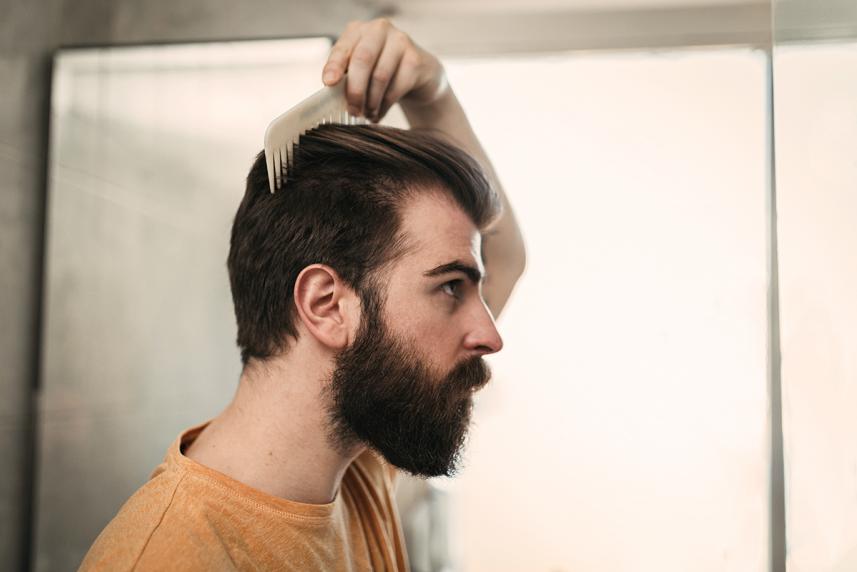
Get discreet care from the comfort of home. No appointments are required and medication can be delivered straight to your door. Plus, we're open 24/7.

Want to stop hair loss before it starts? These simple healthy-hair practices will help preserve your strands for years to come.
We may think of a “good hair day” as achieving a certain look — taming strands to lay flat or to curl just right. But good hair days are rooted in healthy hair, and that includes practices to prevent hair loss. Fact: It’s easier to preserve the hair you have than to replace the hair you’ve lost. Luckily, adopting a few smart habits now can help you keep the hair you have for years to come.
But before you follow the hair loss prevention steps below, consider whether you’ve already started to experience thinning or patchiness. (Read our story on normal shedding versus hair loss for signs.) If so, your first step should be to consult a dermatologist. “It can be very hard for a patient to diagnose themselves with hair loss,” says Susan Huang, MD. She’s a dermatologist in Irvine, California.
That’s because hair loss can result from a variety of things. Sometimes it’s a vitamin deficiency or endocrine problem that’s causing it. “We may want to do a screening thyroid test or check their iron stores or their vitamin D level,” says Stephanie Cotell, MD. She’s a dermatologist at Northeast Dermatology and Cosmetic Surgery Center near Columbus, Ohio.
On rarer occasions, hair loss can be caused by inflammatory issues, infections or illness. A physical examination, blood tests and biopsies can reveal any underlying medical conditions that might need treatment. Find out more about what causes hair loss and how to treat it by reading Hair loss: The Optum Guide.

Get discreet care from the comfort of home. No appointments are required and medication can be delivered straight to your door. Plus, we're open 24/7.
Whether or not you’re experiencing hair loss, the steps below will go a long way toward preserving the strands you have. When experts talk about healthy hair, they’re referring to both the hair and the scalp — they go hand in hand. By properly looking after the scalp, you help ensure that it’s producing the thickest, strongest version of your hair possible. And once that hair has sprouted, protecting it can reduce breakage. Here are 8 ways to give your scalp and hair some love so it’ll stick around.
There are no “hair vitamins” per se, says Carol Haggans. She’s a scientific and health communications consultant with the National Institutes of Health Office of Dietary Supplements. But some vitamins and nutrients specifically help keep your hair and scalp healthy. These include:
The good news is you don’t need to eat exotically: You’ll find these nutrients in foods such as eggs, salmon, avocado, leafy greens, beans and tomatoes. (To learn more about the best nutrients for hair, read The Best Vitamins for Hair and Nails.)
If you aren’t getting enough of these, your body may prioritize more important functions (such as digestion or immunity). The results: Hair gets less of the things it needs to grow and look its best, says Robin Foroutan, RD. She’s an integrative medicine nutritionist in New York City.
If your doctor determines you’re low in any of these, they may recommend supplements.
You can shop for a variety of laboratory-tested vitamins and supplements from the Optum Store. Have them shipped directly to your door. Explore now.
Scalp massages don’t just feel good — they do good. A small study in Japan showed that a 4-minute daily scalp massage with a massage device over 24 weeks increased the thickness of individual hairs, leading to overall thicker hair. Researchers think that a scalp massage increases the blood flow to the area or stretches the follicles, which ends up producing thicker strands.
Another way a scalp massage can help your hair, research finds: It reduces stress. Managing stress has a domino effect on hair health, as stress can cause or worsen hair loss, says Dr. Cotell.
Many of us have heard this old wives’ tale for getting shiny hair. But there can be too much of a good thing, and that includes brushing. The practice can pull and ultimately lead to breakage or split ends.
You need to brush your hair only enough to untangle it, according to the American Academy of Dermatology Association (AAD). Wet hair is particularly fragile, and brushing it can lead to split ends, studies show.
There is a caveat for people with kinky, textured or very curly hair: They should detangle while their hair is wet. Otherwise, they run the risk of increased breakage because brushing dry can cause more breakage than brushing wet. Wide-toothed combs and round-tip brushes are the best tools for all hair types.
This may sound like a no-brainer but keeping your scalp and hair clean is a hair do. Washing gets rid of dead skin, styling products, sweat and environmental pollutants. If residue hangs around too long, it can lead to dermatitis. That’s a condition that can be marked by scaly patches, irritated skin and dandruff. In turn, an itchy, flaky scalp can cause inflammation, which slows hair growth, according to the Cleveland Clinic.
How often should you shampoo and condition? It depends on your hair texture, how often you work out and how much product you use. But washing your scalp and hair every day isn’t necessarily a good idea. Daily shampooing can strip hair of the sebum, or oil, that keeps it moisturized and helps prevent breakage.
For those with curly and coarse hair, washing less often is actually better. That’s because the oil secreted by the scalp gets distributed down the strands more slowly than with straight, fine hair.
Ultimately, you want to choose the frequency that works best for you. You may find that your hair behaves and looks better when you shampoo and condition every day. Or you may be able to do it every week or 2.
If you don’t already condition after you shampoo, add this step to your routine. This is true even if you have oily hair and don’t think you need it. Conditioner helps decrease friction on hair (which leads to breakage). It also makes combing and brushing easier and lubricates the hair cuticle.
The cuticle, the outermost part of the hair strand, protects the inner structure from heat, chemicals and environmental stressors (such as the sun). Coat the ends especially, as it’s the oldest hair. That means it’s been exposed longer to damage, so it needs the extra TLC.
Hairstyles that pull at the scalp, such as cornrows, tight ponytails, buns, extensions or weaves, can lead to something called traction alopecia. With traction alopecia, the constant pressure can damage the follicles. That can lead to permanent hair loss.
These types of hairstyles can also cause breakage. By changing up styles, you give your hair and roots a break. The AAD recommends wearing braided styles for no more than 2 to 3 months. Learn more about women and hair loss here.
Those images from movies and TV showing people vigorously toweling their hair after a shower or swim have it all wrong. Towel-rubbing wet hair can damage the cuticle. The best way to dry hair is by gently wrapping it in a towel or letting it air dry.
Heat also harms the hair shaft by making the outer surface more porous and drier. So if you use a hairdryer, hold it about 6 inches from your hair and move it continuously to minimize damage.
If you use a curling iron, straightener, wand or other heated styling tools, be sure to apply a heat-protecting product beforehand. This helps keep heat damage to a minimum.
Also, avoid using high heat on wet hair: Super-hot temperatures can cause the water in the hair shaft to vaporize into bubbles. Those bubbles stretch the shaft and make it more prone to breakage and brittleness. In general, the higher the temperature, the more the surface of the hair tends to get damaged. So use the lowest possible heat setting that will get the job done.
Once you start working these practices into your routine, they’ll become second nature. Ultimately, your hair and scalp need the same things you do to stay your best: nutritious meals, regular massages and pampering. Treat your hair right and it will stick around for quite a while.

Refill medications, schedule a virtual visit, or shop for health essentials all from the comfort of home.
Additional sources
Scalp massage benefits: Eplasty (2016). “Standardized Scalp Massage Results in Increased Hair Thickness by Inducing Stretching Forces to Dermal Papilla Cells in the Subcutaneous Tissue”
Journal of Physical Therapy Science (2016). “The effect of a scalp massage on stress hormone, blood pressure, and heart rate of healthy female”
Hairbrushing: American Academy of Dermatology Association (n.d.). “Hair Styling Without Damage”
Scalp irritation: Cleveland Clinic (2020). “Is There Any Way to Make Your Hair Grow Faster?”
Caring for Black hair: American Academy of Dermatology Association (n.d.) “Black Hair: Tips for Everyday Care”